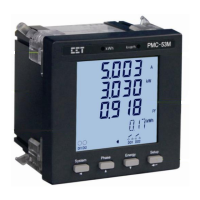Ceiec Electric Technology
33
Table 4-1 Energy
4.2.3 Demands
Demand is defined as the average power consumption over a fixed interval (usually 15 minutes). The
PMC-53 supports the sliding window demand calculation for Ia, Ib, Ic, kW Total, kvar Total and kVA
Total. Demand has the following setup parameters which can be set up via the front panel or over
communications:
# of Sliding Windows: 1-15
Demand Period: 1, 2, 3, 5, 10, 15, 30, 60 minutes. For example, if the # of Sliding
Windows is set as 1 and the Demand Period is 15 minutes, the
demand cycle will be 1×15=15 minutes.
The PMC-53 provides the following Demand parameters. For Peak Demands, both the Peak Demand
value as well as the time stamp are displayed on the front panel. Please refer to Section 3.3 Data
Display for more information.
Table 4-2 Demand Parameters
4.3 Setpoints
The PMC-53 provides four different types of setpoints for different applications.
1) Control Setpoint: General purpose control and alarming applications.
2) Digital Input Setpoint: Provides control output actions in response to changes in Digital
Input status.
3) I residual Setpoint: Residual Current monitoring and alarming
4) Temperature Setpoint: Temperature monitoring and alarming
4.3.1 Control Setpoints
The PMC-53 comes standard with 6 user programmable Control Setpoints which provide extensive
control by allowing a user to initiate an action in response to a specific condition. The alarm symbol
at the bottom of the LCD display is lit if there are any active Control Setpoints. Typical setpoint
applications include alarming and fault detection. The setpoints can be programmed over
communications and have the following setup parameters:
1) Setpoint Type: Specifies the parameter to be monitored and the condition of
monitoring (Over or Under). Table 4-3 below provides a list of
Setpoint Parameters and their associated conditions.

